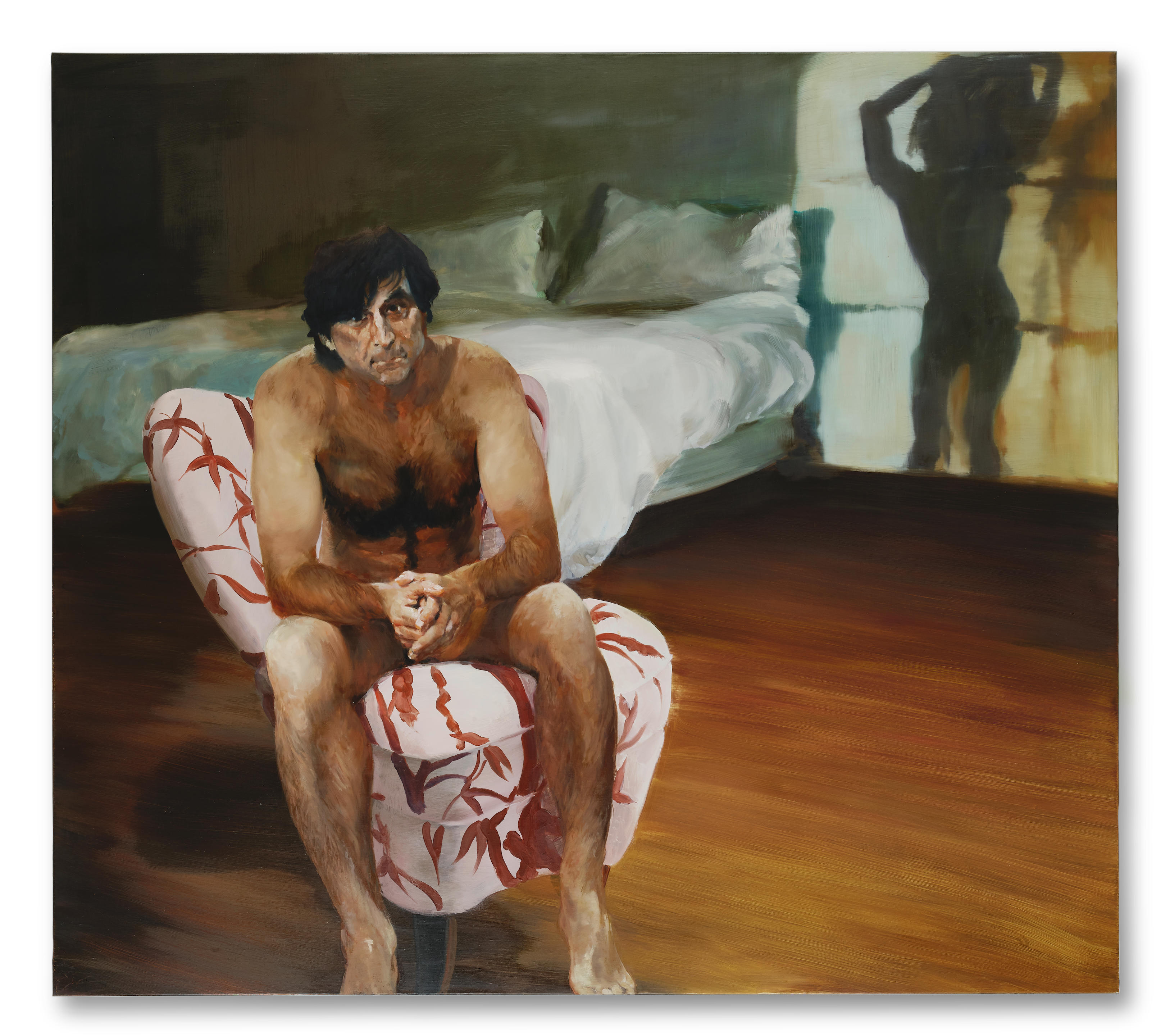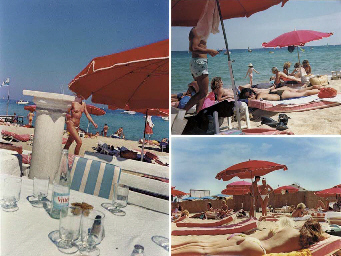Eric Fischl Krefeld Project; Living Room, Scene #4 2002 oil on linen 63 1/2 x 92 inches (161.3 x 233.7 cm) Signed, titled and dated "LIVING ROOM #4 HAUS ESTERS KREFELD PROJECT Eric Fischl 2002" on the reverse.
Provenance Mary Boone Gallery, New York Acquired from the above by the present owner Exhibited New York, Mary Boone Gallery, Eric Fischl March 8 - April 26, 2003 Krefeld, Museum Haus Esters, Eric Fischl The Krefeld Project, October 12, 2003 - January 25, 2004 Literature Eric Fischl The Krefeld Project, exh. cat., Museum Haus Esters, Krefeld, 2004, n.p. (illustrated) Catalogue Essay “What I like about painting is the way you relate to both the image and the object simultaneously. They are inseparable.” Eric Fischl Painter Eric Fischl has spent the past 40 years creating figurative masterpieces, including the present lot, Krefeld Project; Living Room, Scene #4 from 2002. Utilizing photography to capture intimidate human moments, Fischl then transposes these scenes to canvas. The artist explains the reasoning behind his technique, stating, “There is something you can get from the photograph that you can’t get any other way: awkwardness.” This awkwardness is most certainly captured in his renowned Krefeld Project, in which he set up a photo session at the Haus Esters within the Krefelder Kunstmuseen, Germany. The session lasted three days and involved two middle-aged actors, as seen in the present lot. The interior of the home was decorated with fashionable, modern furnishings. Catching everyday scenes within his own calculated and artificially created environment, Fischl took over 2,000 photographs within these three days. A critic explains the mixture of reality and unreality that results from this process: “Photographs of everyday scenes have long been a component of Fischl's repertoire, but here he took pictures of a disruptive mixture of fact and fiction: actors, playing normal people, in an artificial shot, he carefully chose a selection to be used as sketches for twelve large-scale paintings. They capture ambiguous, intimate, and strangely uncanny moments in the bedroom, the living room, the bathroom, the sunroom, and the dining room. It is these new works that appear here, embodying an essential expansion and synthesis of Fischl's previous work.”(M. Hentschel, Eric Fischl The Krefeld Project, Berlin: Kerber, 2004) Krefeld Project; Living Room, Scene #4, seizes an instance of seeming companionship between the male and the female figures. Standing in their lavishly decorated living room, they appear to have just risen from sleep, wrapped in luscious bathrobes. A classic 1960’s Egg Chair upholstered in a deep velvety blue sits behind our female figure; it reflects the morning sunlight, which further emphasizes its tactile plush surface. The white globe lights reflect deep shadows onto the warm white back wall; a feeling of morning freshness washes over the composition. The male, wrapped in a dark bathrobe and black socks, reads the morning paper, having just taken a sip from his white coffee cup on the table, adjacent to a butter yellow vase of white lilies. Our female figure wraps her crimson red robe around her as she exits the scene to the left, presumably headed upstairs to prepare for the day ahead. A few seconds later and she will no longer be in the picture. The couple’s simulated intimacy is conveyed through their conformability as defined by their environment and pattern of living. As a painter, Fischl is only able to catch these split second encounters through the speed of a camera, the image restaged and retold through the process of painting. As he explains, “A photographer doesn’t create a work so much --- he ‘captures’ one. This is not enough for a painter. Paintings are built. They are arrived at.” Arriving at Krefeld Project; Living Room, Scene #4 the viewer is drawn into the fictional nostalgia of the scene and this imagined relationship, this moment passed and shared between two strangers. Asking himself, “What is the relationship of beauty to the psychological truth of your work?” Fischl responds, “It is how one recalls, in all its lucid detail, moments of disturbing or overwhelming significance. That
Eric Fischl Krefeld Project; Living Room, Scene #4 2002 oil on linen 63 1/2 x 92 inches (161.3 x 233.7 cm) Signed, titled and dated "LIVING ROOM #4 HAUS ESTERS KREFELD PROJECT Eric Fischl 2002" on the reverse.
Provenance Mary Boone Gallery, New York Acquired from the above by the present owner Exhibited New York, Mary Boone Gallery, Eric Fischl March 8 - April 26, 2003 Krefeld, Museum Haus Esters, Eric Fischl The Krefeld Project, October 12, 2003 - January 25, 2004 Literature Eric Fischl The Krefeld Project, exh. cat., Museum Haus Esters, Krefeld, 2004, n.p. (illustrated) Catalogue Essay “What I like about painting is the way you relate to both the image and the object simultaneously. They are inseparable.” Eric Fischl Painter Eric Fischl has spent the past 40 years creating figurative masterpieces, including the present lot, Krefeld Project; Living Room, Scene #4 from 2002. Utilizing photography to capture intimidate human moments, Fischl then transposes these scenes to canvas. The artist explains the reasoning behind his technique, stating, “There is something you can get from the photograph that you can’t get any other way: awkwardness.” This awkwardness is most certainly captured in his renowned Krefeld Project, in which he set up a photo session at the Haus Esters within the Krefelder Kunstmuseen, Germany. The session lasted three days and involved two middle-aged actors, as seen in the present lot. The interior of the home was decorated with fashionable, modern furnishings. Catching everyday scenes within his own calculated and artificially created environment, Fischl took over 2,000 photographs within these three days. A critic explains the mixture of reality and unreality that results from this process: “Photographs of everyday scenes have long been a component of Fischl's repertoire, but here he took pictures of a disruptive mixture of fact and fiction: actors, playing normal people, in an artificial shot, he carefully chose a selection to be used as sketches for twelve large-scale paintings. They capture ambiguous, intimate, and strangely uncanny moments in the bedroom, the living room, the bathroom, the sunroom, and the dining room. It is these new works that appear here, embodying an essential expansion and synthesis of Fischl's previous work.”(M. Hentschel, Eric Fischl The Krefeld Project, Berlin: Kerber, 2004) Krefeld Project; Living Room, Scene #4, seizes an instance of seeming companionship between the male and the female figures. Standing in their lavishly decorated living room, they appear to have just risen from sleep, wrapped in luscious bathrobes. A classic 1960’s Egg Chair upholstered in a deep velvety blue sits behind our female figure; it reflects the morning sunlight, which further emphasizes its tactile plush surface. The white globe lights reflect deep shadows onto the warm white back wall; a feeling of morning freshness washes over the composition. The male, wrapped in a dark bathrobe and black socks, reads the morning paper, having just taken a sip from his white coffee cup on the table, adjacent to a butter yellow vase of white lilies. Our female figure wraps her crimson red robe around her as she exits the scene to the left, presumably headed upstairs to prepare for the day ahead. A few seconds later and she will no longer be in the picture. The couple’s simulated intimacy is conveyed through their conformability as defined by their environment and pattern of living. As a painter, Fischl is only able to catch these split second encounters through the speed of a camera, the image restaged and retold through the process of painting. As he explains, “A photographer doesn’t create a work so much --- he ‘captures’ one. This is not enough for a painter. Paintings are built. They are arrived at.” Arriving at Krefeld Project; Living Room, Scene #4 the viewer is drawn into the fictional nostalgia of the scene and this imagined relationship, this moment passed and shared between two strangers. Asking himself, “What is the relationship of beauty to the psychological truth of your work?” Fischl responds, “It is how one recalls, in all its lucid detail, moments of disturbing or overwhelming significance. That
.jpg)


.jpg)
.jpg)
.jpg)






.jpg)
Try LotSearch and its premium features for 7 days - without any costs!
Be notified automatically about new items in upcoming auctions.
Create an alert